New Morning, New Day | 2021 Maine Artists
Featuring 25 Maine artists, this juried exhibition celebrates art and creativity in the Pine Street State.
Meet the Judges
WREN MANLY is the director of external affairs for Indigo Arts Alliance, a Black-led artist-in-residency program for Black and Brown artists based in Portland. She is responsible for cultivating professional affiliations and alliances and developing new collaborations with individual and corporate partners. She previously worked at the Smithsonian Institution’s Freer Gallery of Art and Arthur M. Sackler Gallery and the Smithsonian’s National Museum of African American History and Culture.

PATRICIA KING is the vice president at Waterville Creates, a coordinating entity for arts and culture in Waterville. She has held leadership and administrative positions with academic and museum institutions including the Colby College Museum of Art, the Museum of Fine Arts in Boston, the School of the Museum of Fine Arts in Boston, and the Addison Gallery of American Art in Andover, Massachusetts. She is also a board member for the Star of Hope Foundation in Rockland.

HILARY IRONS, Maine magazine’s arts columnist, is a painter and curator living and working in Portland. She is the gallery and exhibitions director at the University of New England and a cofounder of Able Baker Contemporary in Portland’s Arts District as well as an educator teaching at the Maine College of Art and Bowdoin College.
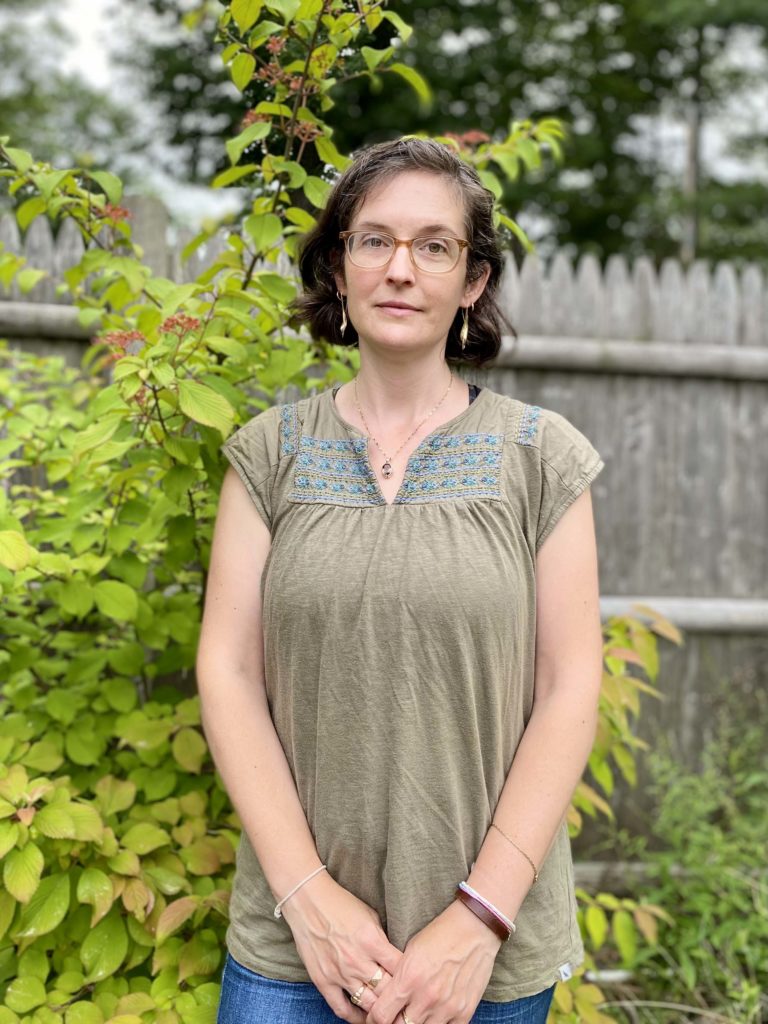
DINAH MINOT is executive director of Creative Portland, the city’s official nonprofit arts agency whose mission is to promote the creative economy through the arts. Creative Portland established an artist relief fund during the pandemic to nurture and help sustain the arts community, and Minot is currently spearheading the development of a digital cultural app to increase access to the arts, with event listings and maps of creative placemaking initiatives, art galleries, music venues, and self-guided cultural tours of Portland.

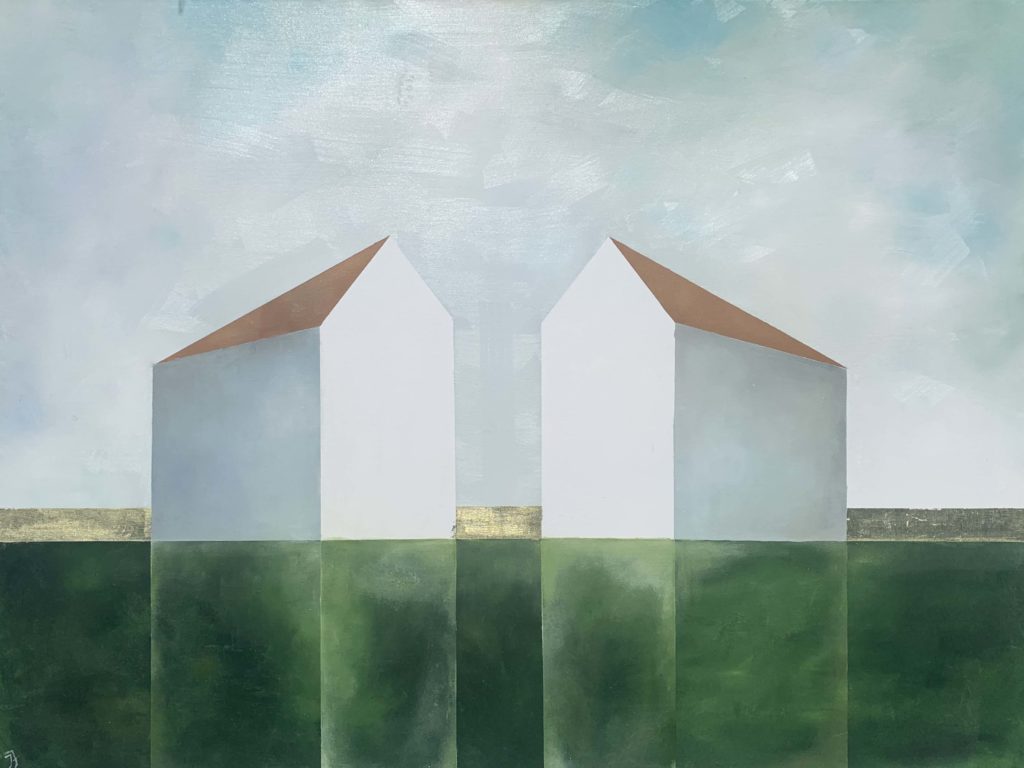
Oil on canvas with 18-karat gold leaf, 36″ x 48″ | Maine Art Hill | Kennebunk | maine-art.com
Ingunn Milla Joergensen
For as long as I can remember I have had a fascination with texture and aging objects, particularly simple everyday things with stories that are equally important to me as the object itself. Standing inside a huge old barn when the sun is beaming through all the gaps fills me with great respect for those who, with such perseverance and hard work, created it. The function is first and foremost, but I always find a proud touch of simple decor. These buildings are not pretentious but honest. To me they are beautiful monuments. Built to shelter, they are such essential constructions, left standing for generations. Then there is that sense of mystery, the darkness and dust, silence and
presence. This is what I try very hard to achieve in my work—the sense of something timeless, grounded, peaceful, quiet, and the presence of something absent.

Acrylic on canvas, 28″ x 22″ | Green Lion Gallery | Lyme, New Hampshire | greenlionart.com
Elizabeth Starr
My art is a visual expression of my love of nature, particularly my deep connection to the wild lands, and the granite coast. My art is a seeking and searching process, a soul peering out and into the great green living ecosystem that beckons me daily. I am a part of this seacoast world here around me. I breathe it in, and I paint what I see and what I feel. The power of this place, coastal Maine, gives me inspiration that can only be called spiritual.

Woodblock print on paper, 30″ x 22″
Kristy Cavaretta
This woodblock print is part of an ongoing series about the paradox of motherhood. As a mother to three young children, I have a great sense of pride in knowing that I am the embodiment of safety, nourishment, and security for them. At the same time, I often find myself overwhelmed by the physicality of having them climbing on and clinging
to my body all day. Inspired by the rocky coast of southern Maine, I looked at the boulders covered in barnacles, seaweed, and snails and wondered, “Do they feel the same pride to have been chosen as the homes to protect these precious beings, or do they some days miss the feeling of the waves crashing against their surface unobscured?”

Oil monoprint, 18″ x 18″
Joan Busing
As a painter my focus is on monoprinting and making unique one-of-a-kind prints. In monoprinting, I take the painting process one step further by first doing the painting on a plexiglass plate, then printing the finished plate on paper in a press. I love the process of printing a painting. My work changes constantly, and I always look forward to the challenge of the next working day.

Abstract photography, 20″ x 30″
Dominic Cordisco
This image is part of a series of photographs called Light on Water, which had a recent successful showing at 2 Alices Coffee Lounge in Cornwall-on-Hudson, New York. I hope these images bring a moment of reflection of the luminous world we all live in.

Plaster and mold, various sizes
Bethany Engstrom
I am interested in our considerations of life and the spaces we encounter, the spaces between philosophy, society, psychology, and pop culture, and the uncomfortably strange sensation that we experience within these areas. I seek to push the ordinary and mundane further to approach the unknown and connect with others through shared encounters. This interest has led me to the production of objects, installation, audio, and video works that allow me to analyze and draw attention to this unknown using a suggested narrative. My most recent work looks to these ideas with explorations of time, labor and work, and motherhood.
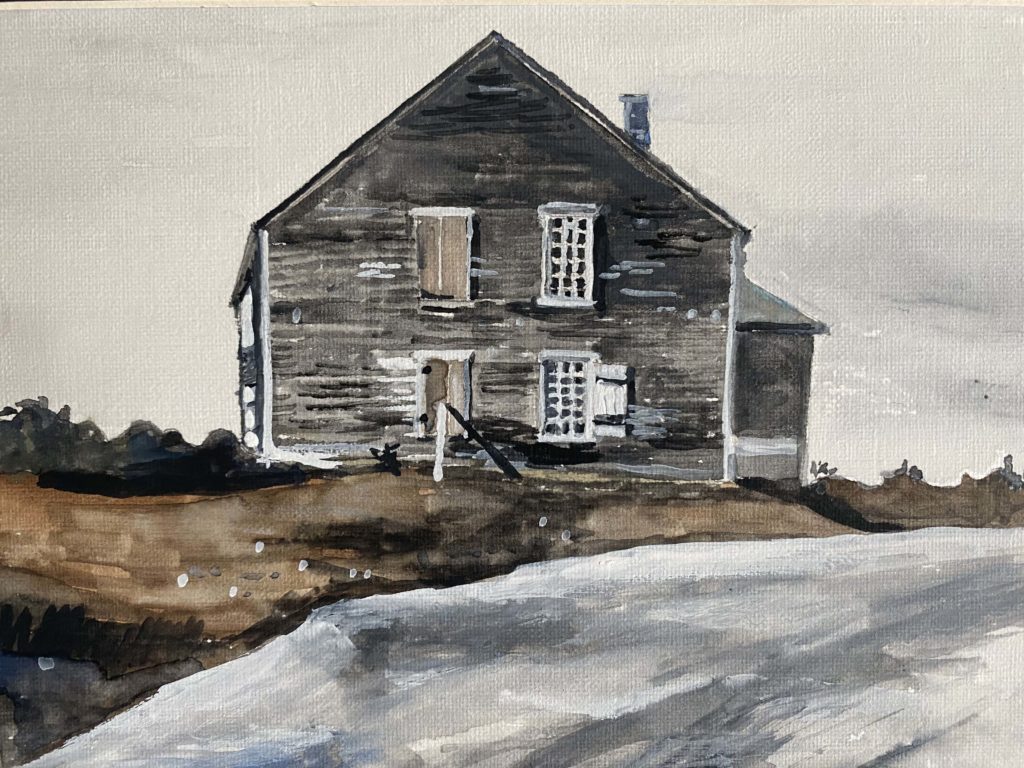
Watercolor, 5” x 7”
Anthony Pierce
I focus on capturing snapshots of daily life. I often interpret old photos through paint to emphasize the composition and often accidental juxtaposition or historical perspective.

Burnished acrylic and wax on canvas, 46″ x 42″
Joshua Ferry
My father was an Episcopal minister. When I was a boy, I liked to look at the altar cloths in his church and imagine how I might design them. I noticed that throughout the year the colors and designs of the cloths would change depending on the religious calendar. Some weeks the linens were green, others red, then purple and so on. I select the colors in my paintings intuitively and strive to never have a color repeat. If there are four reds or five blues or three greens on a canvas none of them are the same. Although these paintings aren’t intended to be religious, I wonder if my early experience in my father’s church was an influence. This series has also made me think about quilting, cemetery rows, wall structures, and the diversity and connectedness of people.
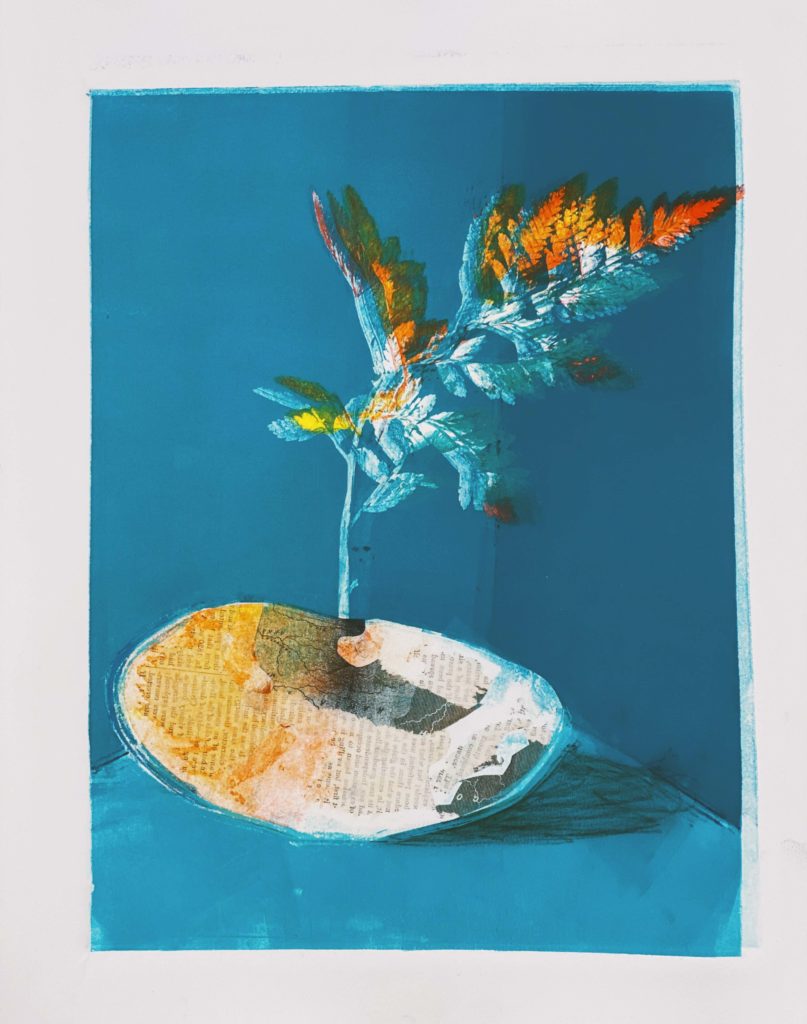
Relief ink, chine collé, mixed media on paper, 14″ x 11″
Jess Shaps
Years of improv comedy prepared me for a medium that thrills me just as equally: printmaking. On stage, all my attention is needed to stay close to what is unfolding so that I can make in-the-moment decisions. I bring this influence to my monotypes, screen prints, and cyanotypes. The ideas for prints can be immediate, evolving each time I pull the paper from the plate and press. Sometimes my ideas are slow to form, morphing over days, weeks, and months. Rather than getting stuck in thought (an uncomfortable place to be on or off stage for me), I stay present in process, and it reveals everything. I’m interested in the birth, death, and rebirth cycle of ideas and the intersection of nature and design. Often my ideas for prints arise during walks in Robinson Woods Preserve.
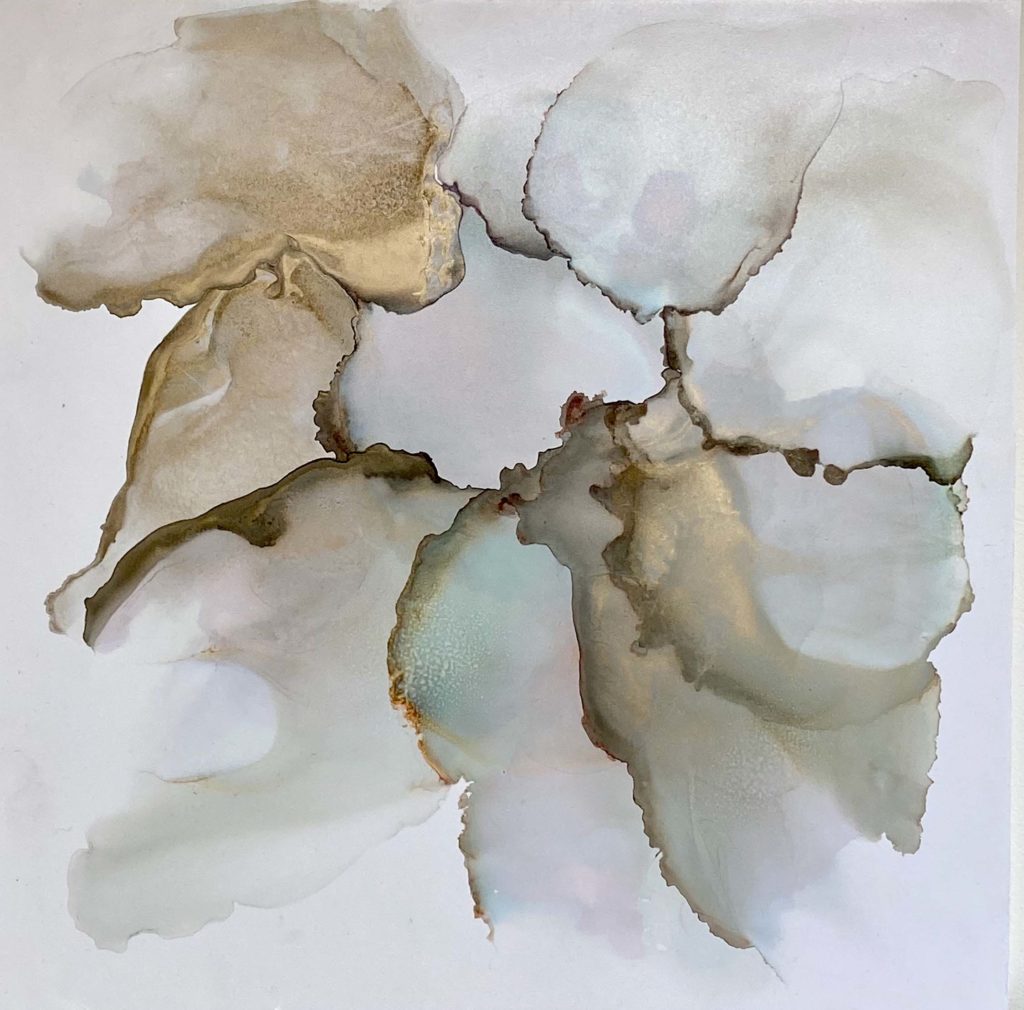
Alcohol inks, 10″ x 10″
Kris Lape
This body of work was created during the COVID-19 shutdown. I have mostly been a realistic painter, until COVID. I began working with alcohol inks, which are extremely hard to control, much like the way I was seeing the virus affecting us all. I could create work that resembles something I know but had to let the rest of the process take its own direction. It was a frustrating, enlightening, and lovely process for me. I found myself creating vivid flower, landscape, sunrise, and sunset paintings that made me surprised and soothed. I also created some ethereal and universe pieces. The search for peace has been hard during this time, and beauty is so necessary. All work is unique, original, and can never be recreated. I have found these pieces of work represent a type of control and letting go that we have all had to experience as of late.

Acrylic on canvas, 20″ x 16″
Anne Schutz
I grew up in Maine near the ocean, lakes, and farms. We had many gardens at home. My relationship with nature and the natural world continues to evolve. Color, light, and infinite changes in motion or the passing of time become idiosyncratic expressions of pattern and form that I translate. I celebrate impermanence and interpret change in paint.

Archival digital print, 10″ x 10″
Britt Sondreal
“There is another world, and it is in this one.” —Paul Éluard
Home is both a physical experience and an abstract concept. When it becomes our only experience of the world, it can be simultaneously limiting and limitless. I began to look for small moments of expansion in the minutia of the everyday, little glimpses of the larger universe from within the confines of home.

Oil on canvas, 38″ x 56″
Tyler Clements
I am interested in finding the right balance in a painting. This usually refers to a sense of weight and structure. If the art is too simple, it feels frail to me, and if it is too chaotic, it feels overburdened. My process of painting, then, typically bounces between these two states until some resolution is found. Faced with a blank canvas, I typically start by free drawing in pencil—random lines and forms that coalesce into some rough composition, oftentimes a scene. I then spend most of my time unbalancing the composition, then rebalancing it until it feels steady. I am interested in depicting the fragility of the human condition wrapped in its tough husk.

Quilt, 85″ x 87.5″
Christopher Dudley
I am a carpenter by day, a creative at night. The quilts I make are abstract representations of landscapes, whether real or imagined. Some are tied together; others are machine sewn. All work, from design to finished quilting, is done with my hands and an old sewing machine. I’ve made furniture and lighting in the past and currently flip-flop between creating small sketches and quilts. Why do I make things? I don’t know the answer to that, other than I would be sad if I didn’t.

Photography, 36″ x 24″ | Black River Gallery | Boothbay Harbor | blackrivergallery.com
Catherine Day
My passion lies in nature, and my hope is that my images depict the depth of that passion. I believe a photograph is not just a picture to be admired but rather a way of capturing an evocative image that conjures a feeling of magic and wonder in the viewer.
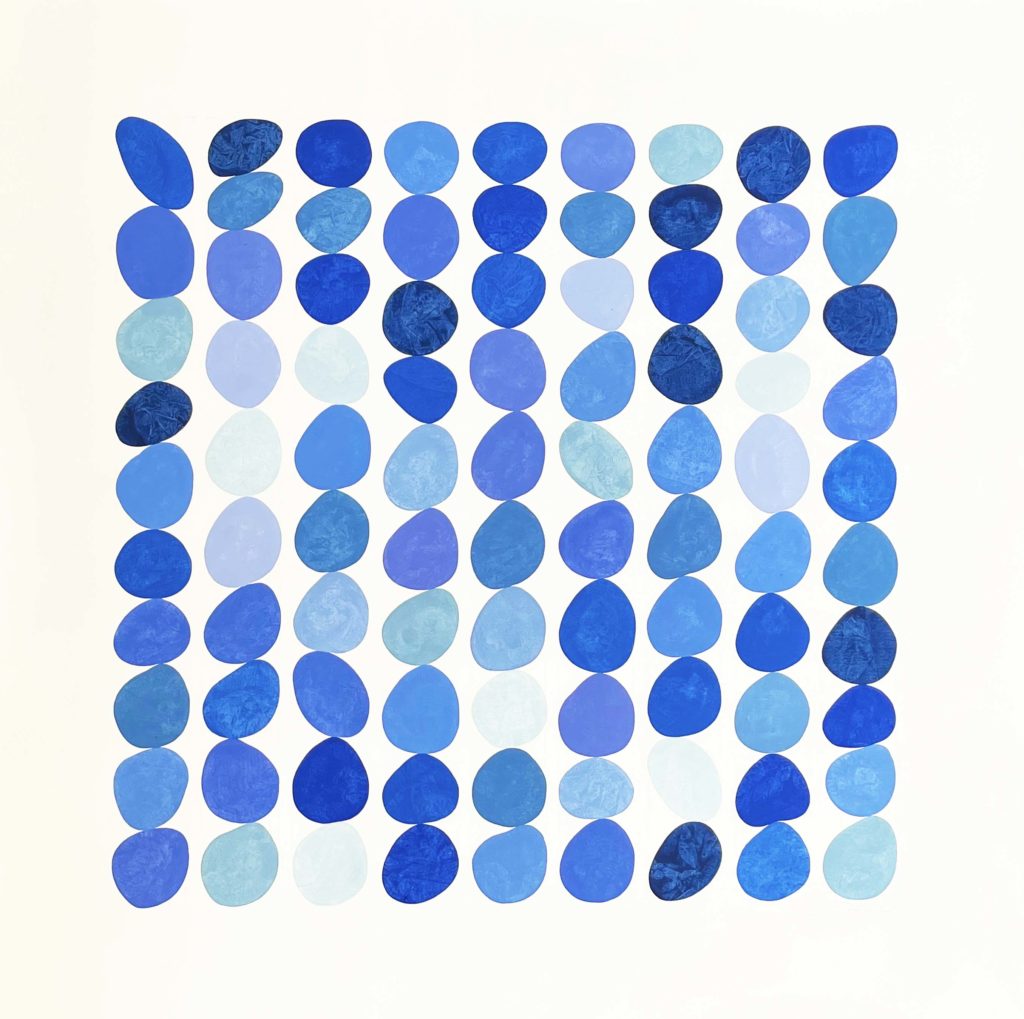
Gouache on paper, 42″ x 42″| Portland Art Gallery | Portland | portlandartgallery.com
Nancy Simonds
I make large-scale abstract gouache paintings on paper and panel. In each of my BLOCK STACK, OVOID, and ARC series, different arrangements of ovals and colors create a feeling of transcendent order. All strive for a connection to a moment for reflection, resolution and calm. My works have luxuriant protean color and are infused with sublime, soft texture. In my OVOID series, squares without edges, I enjoy the play of organic shapes against the white of the background creating tension as the ovals touch or separate in varying degrees. These images reflect velvety textures, such as moss-covered earth, as well as disparate edges, sizes, and patterns coexisting in nature. My paintings are inspired by the rocks found in the woods and by the rocky shores in Maine.
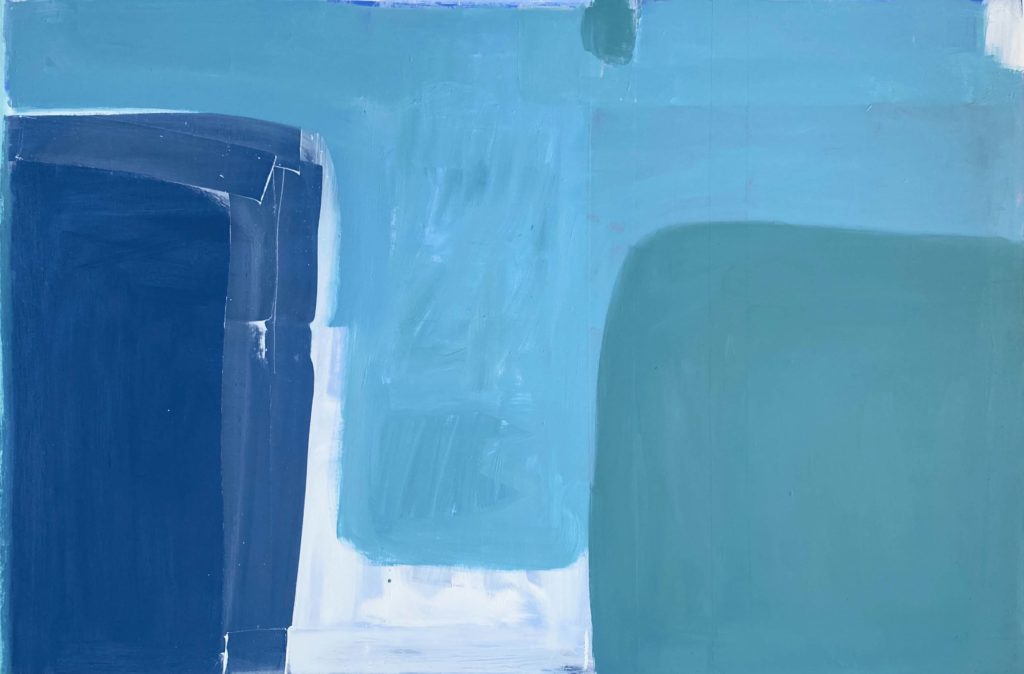
Oil on canvas, 40″ x 60″ | The Willard Gallery | South Portland | thewillardgallery.com
Laurie Fisher
Color is the subject, the process, and the means in my work. As I work, I’m inspired and reinspired by color and by the paint itself. Every painting and body of work is built up over time, each layer and mark influencing the next. My choices are intuitive, all echo of aliveness, nature, and the outside world—I’m unconsciously imprinted by the sea, smells, flashes of color, shape and light, incongruousness, and harmony.

Earthenware clay, various sizes
Kari Radasch
My earthenware pots are both sparse and embellished. Structurally my dishes are very straightforward, yet the surfaces tend towards bold, graphic, and at times peculiar ornamentation. I revel in this dualism by collecting, arranging, and garnishing, then organizing, simplifying, and editing both my forms and surface. I pluck joyous observations from my surroundings. I reassemble and reimagine these investigations, like sketches in a sketchbook, onto functional dishes—a format that has the unique ability to hold a warm sentimental place in our lives. I don’t have any illusions that my pots are used on a daily basis. I have always been a fashion-before-function kind of gal. I think of my dishes as the platform shoes of pottery—they are party pots with utilitarian concerns. I make pots to bring joy to others’ lives. It is a true gift.
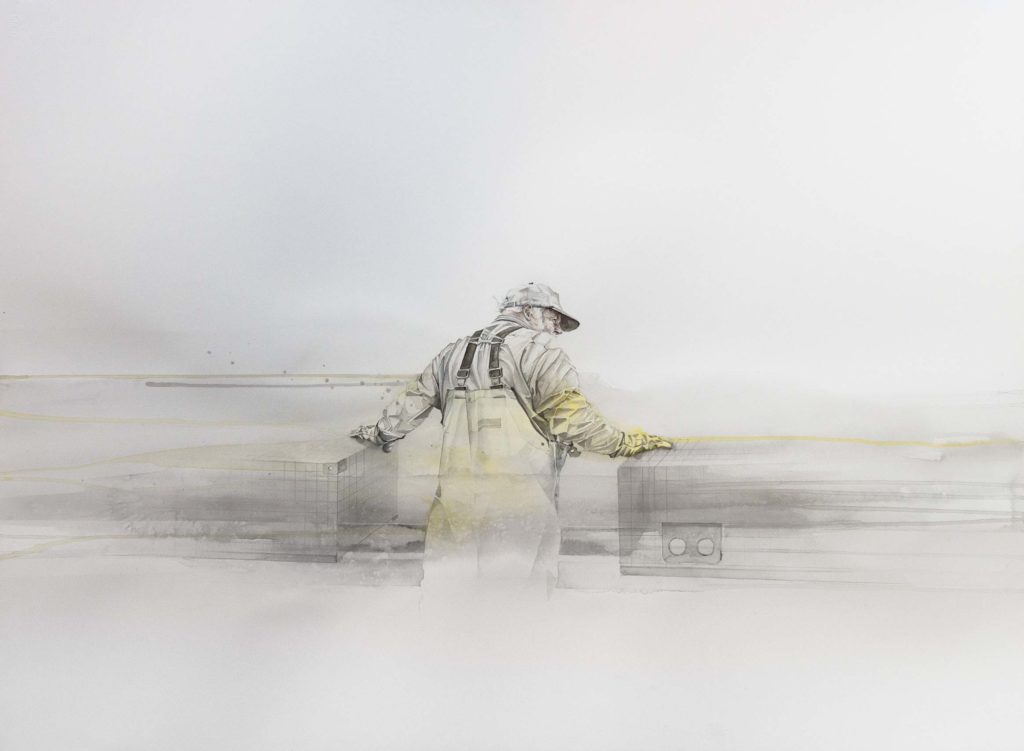
Watercolor on paper, 22″ x 30″ | Artemis Gallery | Northeast Harbor | artemisgalleryme.com
Abe Goodale
I focus on watercolor portraiture and the representation of an era. My deep passion for the arts and anthropology inspire me to look at the way humans engage with one another and the surrounding environment. I see the arts as a platform to instigate change, to preserve culture, and to provide visually enticing images that may document a way of living in an ever-changing world. My goal is to create paintings that are not only visual depictions but also personal expressions of the individuals I portray. I strive to capture an emotion, a subtle gesture or attitude that may allow you, the viewer, to react and feel.

Photograph, archival print on paper, 20″ x 21″ | Portland Art Gallery | Portland | portlandartgallery.com
Nina Fuller
My art is on an ever-changing journey. For the past 50 years, I have worked as a professional photographer in the commercial world while always taking photos to express my own self. Today, I run a sheep farm in Hollis, Maine, and am slightly obsessed with photographing the sheep. This art journey has been going on for the last ten years, and I can’t tell you when it will end.
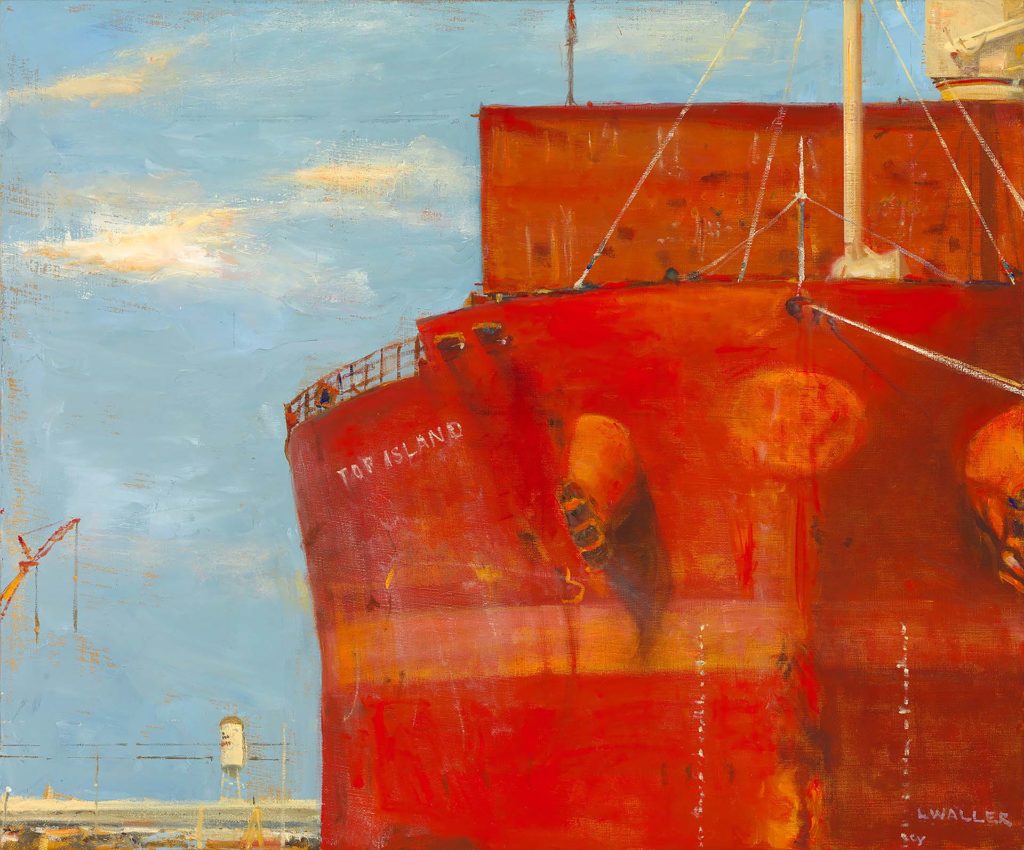
Oil on linen, 20″ x 24″ | Elizabeth Moss Galleries | Falmouth | elizabethmossgalleries.com
Laura Waller
Intrigued by the massive commercial ships and vessels I found at the Port of Tampa Bay, near my Florida studio, I began my Working Waterfront series of paintings in 2013. From a small powerboat providing a water-level perspective, I photographed what I saw happening within this international shipping hub: the process of loading and offloading containers, tugs transporting ships to and from the port’s narrow channels, and vessels in dry dock for maintenance and repair. I accompanied a harbor pilot taking a ship from the channel, through Tampa Bay, out to the Gulf of Mexico. I am beginning to paint ships at the Port of Portland in Maine, where I have a studio, as an extension of the Working Waterfront series. Focusing on specific elements, which can shift between abstraction and representation, I am interested in exploring how natural light in the Northeast differs from Florida’s sunlight and how shapes and colors are perceived.

Acrylic on panel, 30″ x 30″| Greenhut Galleries | Portland | greenhutgalleries.com
Mary Bourke
My work is deeply seated in the natural world, either through landscape, animals, or the human form. I think the world can be a lonely place, and that it is something each one of us struggles with at various times in our lives. Nature has always been a soothing answer for that feeling, at least for me. Sometimes being faced with the wilderness, I find it easier to feel like I am just one small part of a very large picture.
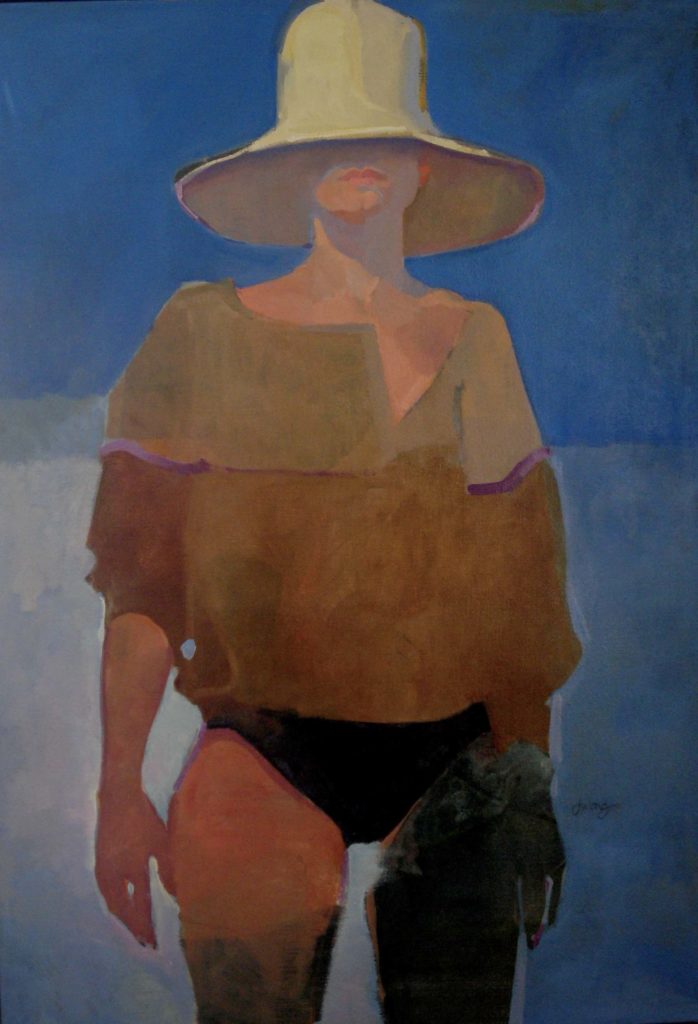
Oil, 48″ x 36″
Pamela duLong Williams
My passion has always been painting and drawing the figure. I have worked from a live model at least once a week since 1967. My love for the figure evolved into portraiture in 1975 and has continued to captivate my interest. Although I have never taken a portrait class (as most traditional portraiture leaves me unmoved), I have taught myself portraiture through the impressionist school of painting. Preferring to work from life, I am able to interact with the sitter, engaging them in conversation about themselves, which enables them to open up to me. At that point I simply paint what they show me.
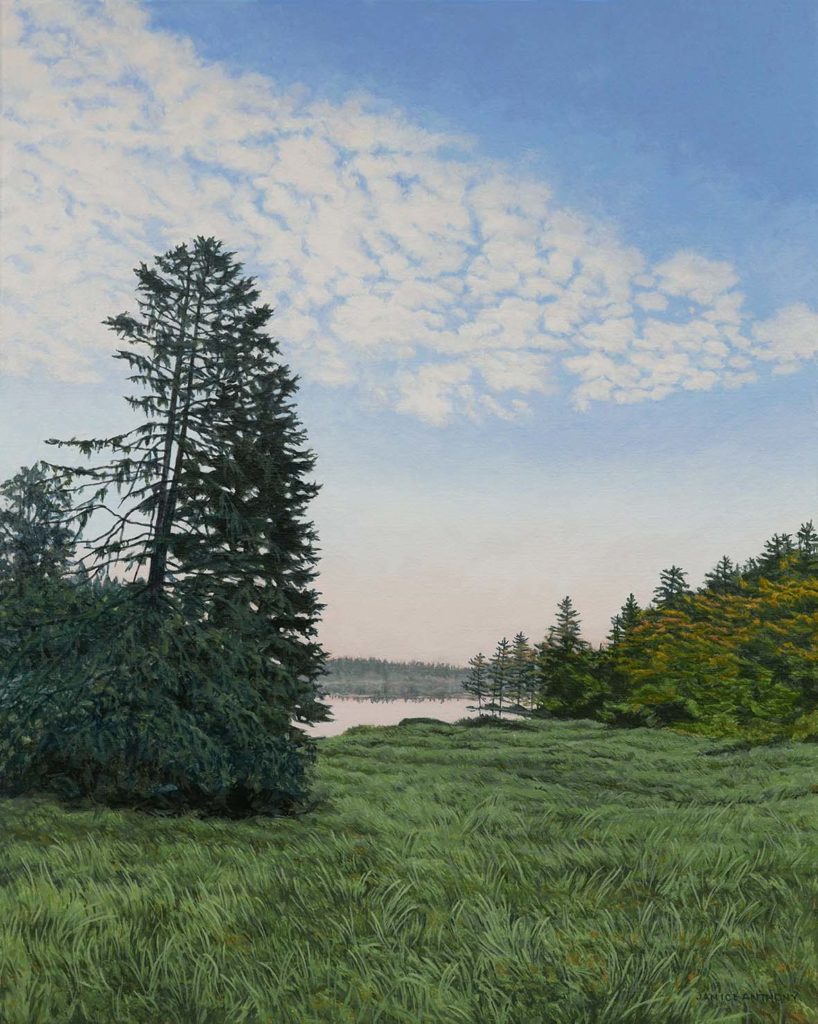
Acrylic on linen, 20″ x 16″
Courthouse Gallery | Ellsworth | courthousegallery.com | Gleason Fine Art | Boothbay Harbor | gleasonfineart.com
Janice Anthony
The content of my paintings lies beyond the visible features of the forest and rocks and water. My intention is to convey the sense of a place: the moving air, the solidity of rock, the transience of water, and the strength of the ground beneath. I feel a great affection for the otherness of the natural world, for a place that I have just entered that existed autonomously before I saw and felt it and that continues to exist when I leave. What I depend on is the separateness of wilderness. For me the magic of the landscape is that it is actually a parallel world to that of humankind. I am delighted when I find a place that is perfect in its wholeness, clearly a world apart, that requires nothing of me and that offers me nothing but a vision of its self-sufficiency. I don’t want to be merely in a place that exists outside and beyond me, I want to become that place. The act of painting unites me with a wilderness that I recognize within myself.
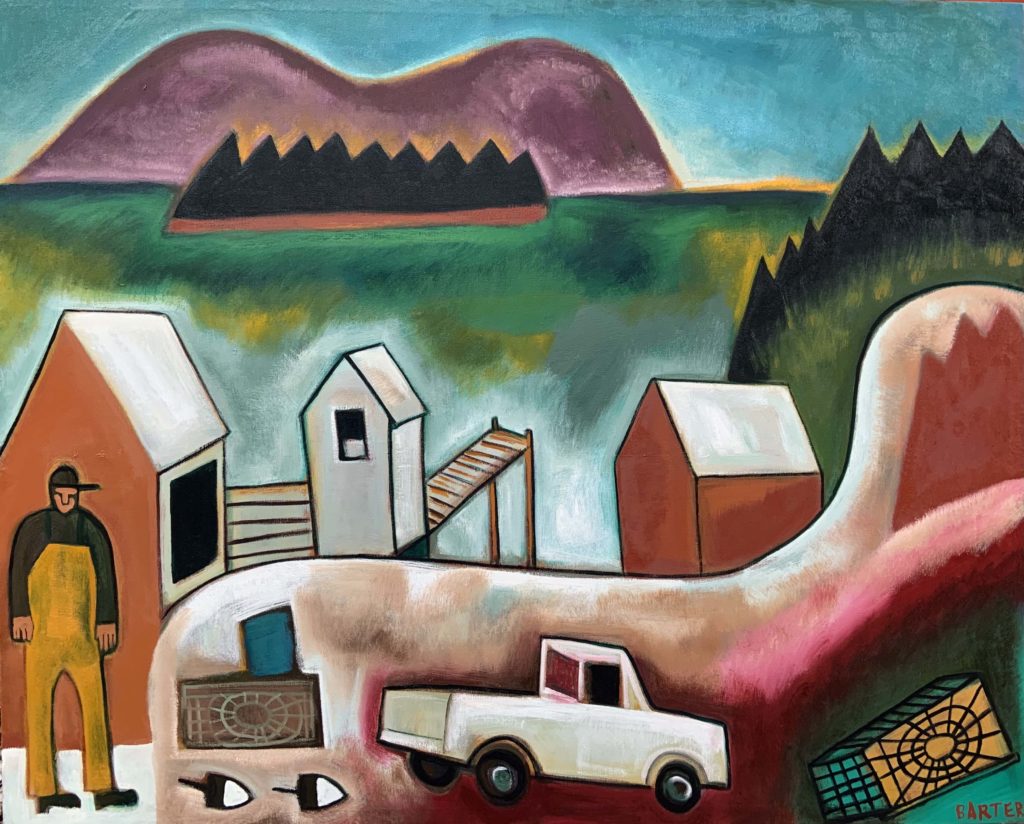
Oil on canvas, 40″ x 54″ | Portland Art Gallery | Portland | portlandartgallery.com
Matt Barter
I paint and sculpt the Maine experience, from the fishing villages to the wooded mountain regions. I focus on the working harbors from Harpswell to Jonesport. I love bringing out the stories of the fishermen and their families as they make a living in a difficult trade. I studied with my dad, Philip Barter, when I was a teenager in his studio in Sullivan. I’ve traveled and lived all over the country doing my own art studies and settled in Brunswick with my wife, Rebekah, and two sons, where I have my studio and Barter Art House Gallery.
Read more arts stories:
- The Immortal Life of Holly Meade

- “Beyond the Brick” Brings Maine-Made Art and Music to Life

- Watercolor Painter Abe Goodale Traces His Roots on 700 Acre Island

- Shifting Dynamics Through the Power of Theater


